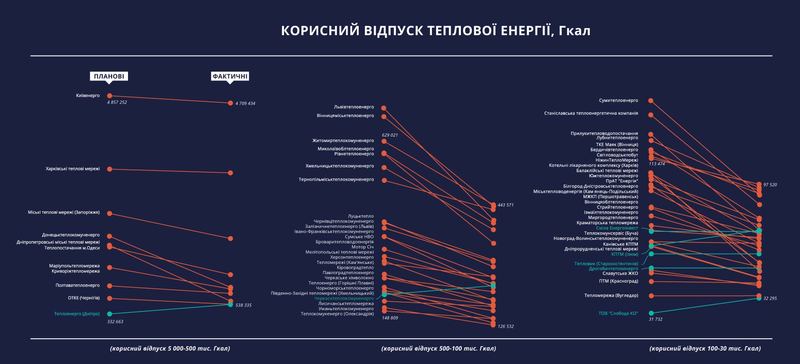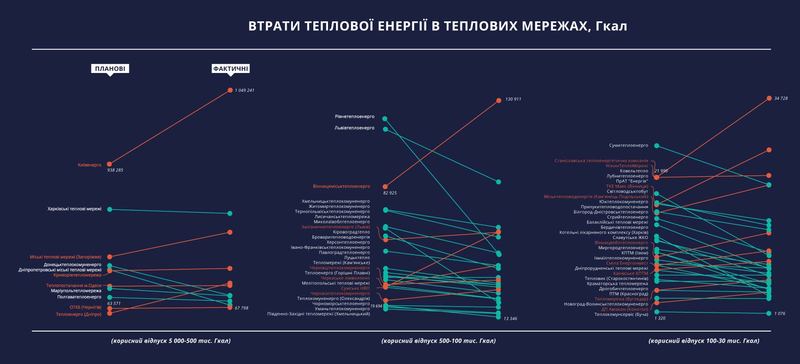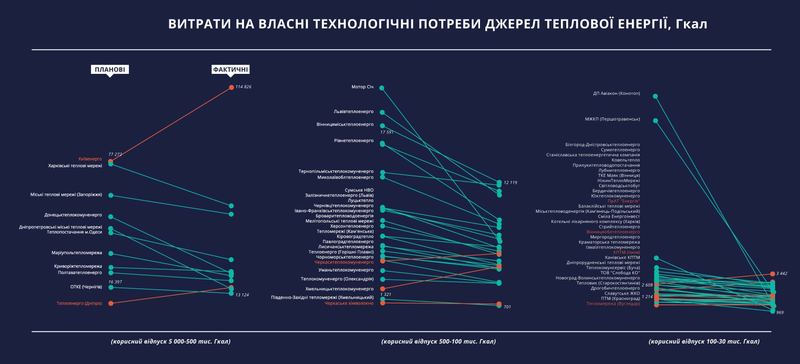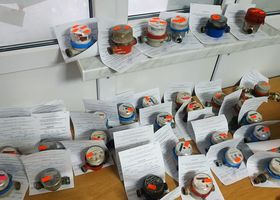Warm tariff: where does consumers' money go?
The new heating season is bringing a significantly higher figure in the total utility bills with the heating costs added.
When energy was cheap, people did not have any motivation either to save heat or look closer into the bills, and especially into the complicated tariffication process. To find out the final sum due, you need to multiply the amount of consumed services determined by your meter or standard consumption rate (unfortunately, not all Ukrainian buildings are equipped with heating meters so far) by the set tariff. While the consumption depends completely on us and our neighbors (as in an apartment building), we have too little to do to control the tariff. But knowledge is power, so it is important for us to understand how the monopolists use the money they collected from us.
This article discusses issues of centralized heating and heat supply.
The heating tariff is a monetary equivalent of the cost of production, transportation, and supply of 1 Gcal of heat of the appropriate quality. In order to calculate the cost of 1 Gcal (tariff), it is necessary to add the planned profit to the economically justified planning expenses of the enterprise, less the losses, and to divide this sum by the planned volume of heat supply.
But how relevant are the planned figures? Is every hryvnia paid for heating used for the planned purposes?
The structure of tariffs (spending plans) of each enterprise can be found in the relevant tariff-approving resolutions of the NEURC (available to licensees of the commission). But finding the actual data is not an easy task. They are not available in the public domain. There is also no single reporting source to provide intelligible information about the actual outlays (the numerator) and sales (denominator) of heat supply companies.
Nonetheless, some important information about heat outputs and sales, costs, and, most importantly, transmission losses, can be obtained from 1NKP and 2NKP reports for 2016. The information received from the NEURC in response to a request covers one hundred and nine licensees (with full data concerning eighty-two of them). Therefore, the infographics and analysis are based only on the data of these enterprises.
To calculate the volume of sales (useful release of heat), you need to deduct the outlays of heat supply companies for their own needs and transmission losses from the heat output.
As seen from the reports, the enterprises have produced considerably less heat than planned. On average, down 23 percent from the target. For some companies, this gap is striking. For example, Dnipropetrovsk Municipal Heating Networks UC produced only 673,944 Gcal (33%) of the planned 2,069,941 Gcal, Brodyteploenergo put out 47,450 Gcal (37%) of the 17,788 Gcal target, and Teplo UC of the Pervomaysk City Council topped the list of losers with only 19,654.5 Gcal produced (19%) against its 105,620 Gcal target. However, there are a few companies that have fulfilled and even exceeded their plans. In particular, the utility company Teploenergo of the Dnipropetrovsk City Council generated almost twice as much heat as planned - 733,699 Gcal against the planned 380,268.4 Gcal.
The outlays of the companies for their own needs - both planned and actual - make up about two percent of their output. Of course, there are exceptions, but they do not affect the overall picture. For example, the actual production costs of Vinnytsyaoblteploenergo UC exceed one and half times the plan, with its output being 12 percent less, and the production costs of Energy Company PJSC exceed the plan by a third while its output has fallen short by 22 percent. On the other hand, Bilhorod-Dnistrovskteploenergo UC, State Enterprise "Konotop Aircraft Repair Plant AVIACON," and Hlukhivskyi Teplovyi Raion UC spent much less heat on their own needs than planned.
Thus, the actual release of heat from the collectors is 23 percent less on average in Ukraine than the figure planned in the tariffs.
But not all the produced heat less production costs (that is, the heat released from the collectors) gets to the consumer. There are also transmission losses. The tariffs include the standard losses determined on the basis of scientific methods. Therefore, we compensate for them. In some cases, the regulator may allow higher losses in the tariffs (subject to the decision of the local self-government body).
On average, these losses make up 12 percent of the heat released from the collectors. Of course, there are exceptions.
The holders of top positions in the rating of enterprises with the lowest losses compensated for by consumers through the tariff are: Teplovodpostach LLC (6%), Novohrad-Volynskteplocomunenergo UC (5%), and the private utility company Teplocomunservis (2% only).
The highest planned losses are in Sumyteploenergo LLC (16%), NizhynTeploMerezhi LLC (16%), Kyivenergo PJSC (16%), Kryvorizhteplomerezha UC of Heating Networks (16%), Kirovohradteplo SE (17%), Rivneteploenergo LLC (17%), and Slavutske Housing and Utilities Association UC (19%).
As a matter of fact, over 15 percent of heat on average is lost in the networks. The leaders in terms of wasted heat are VMR Vinnytsyamiskteploenergo UC (23%), Teplo UC of the Pervomaysk City Council (24%), SE Teplokomunenergo Mayak - Mayak PJSC (25%), Stanislavska Heat and Energy Company LLC (29%), and Teploenerhetyk UC (as much as 47%).
The lowest actual product losses are in the networks of the private utility company Teplokomunservis (2%) and Novohrad-Volynskteplokomunenergo UC (5%).
The widest gap between the planned and actual losses are in Teploenerhetyk" (47% and 9%), VMR "Vinnytsyamiskteploenergo UC, SE Teplokomunenergo Mayak - Mayak PJSC, Vinnytsyaoblteploenergo UC, Kryvorizhteplomerezha UC of Heating Networks, Teploenergo UC of the Dnipropetrovsk City Council, Municipal Heating Networks Concern (Zaporizhzhya), Stanislavska Heat and Energy Company LLC, Teplo UC of the Pervomaysk City Council, Sumske R&D PJSC, and KPPV Directorate.
Can the data provided in the reports be taken as valid? The undoubted "yes" would be possible only if the supplied heat was accurately metered at every stage from production to every radiator in an apartment (or at least to every general building meter).
As of September 2017, approximately 70 percent of buildings in Ukraine had heat metering units installed, in 2016 (the year we are analyzing here), this percentage ranged between 40 and 60 percent. The relatively high percentage of buildings with heat meters installed owes primarily to the city of Kyiv while this percentage for some other cities and oblasts is 30% or less.

If there is metering in place, the consumption volume is determined on the basis of the standard consumption rates, which are on average 20 percent higher than actual consumption (established using metering devices), and the actual situation differs from building to building. Accordingly, the actual losses in the networks may be higher (experts name the average figure of 20 percent). Therefore, the lower the coverage of buildings with installed heat meters, the more difficult it is to determine the actual amount of heat consumed by residents and actual losses in the networks.
Nevertheless, the reports provide the following data of useful release or heat sales to households.
On average, the population consumed 26 percent less heat than planned, which means saved energy. The smallest proportions of their planned heat sales to households were accounted for by Hospital Complex Boiler Houses LLC (43%), Brodyteploenergo (35%), and Teplo UC of the Pervomaysk City Council (16%). The actual and planned sales figures perfectly coincided in Kramatorsk Heating Network UPC of the Kramatorsk City Council, Teplomerezha UC of the Vuhledarska City Council, Novohrad-Volynskteplokomunenergo UC, Drohobychteploenergo UC of the Drohobych City Council, Kharkiv Heating Networks UC, Smila Energoinvest LLC, and Kyivenergo PJSC.
The enterprises that over-fulfilled their plans were Teploenergo UC of the Dnipropetrovsk City Council (162%), State Enterprise "Konotop Aircraft Repair Plant AVIACON" (144%), Cherkasyteplokomunenergo UC of Heating Networks of the Cherkasy City Council (116%), and Izyum Municipal Enterprise of Heating Networks (116%).
What is the bottom line? Heat supply companies have collected less money from the population than planned. But were their production, transportation, and supply costs lower? Theoretically, yes. And they actually needed less gas than planned (considering that the bulk of the production costs is the fuel component).
But the available reports to not make it clear how much lower their total costs were. This is especially interesting in view of the fact that the actual losses in the networks (the costs included in the tariff numerator) were greater than planned.
This material has been prepared as part of the USAID Transparent Energy project. The project aims to fight corruption and improve financial transparency in Ukraine's energy sector. Source: https://reforms.censor.net.ua/m3034709











